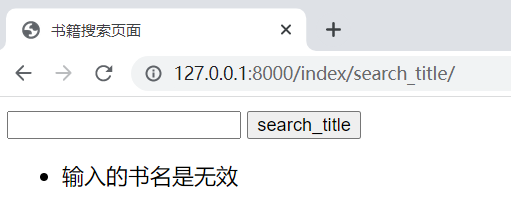Django框架基础9
本节重点:
1、实现表单验证
2、实现添加书籍、更新书籍、删除书籍的功能。
3、静态文件配置(嵌入css、img和js文件)
一、DjangoHTML表单实例应用
接下来要增加一个书籍搜索的功能,即输入书籍的 title 就可以得到想要查询的书籍信息。
1、
在页面中提交表单可以使用GET请求也可以使用POST请求,相应地,就可以通过 request.GET 或 request.POST 在视图中获取表单数据。
GET 和 POST 这两种 HTTP 请求类型用于不同的目的,对于改变系统状态的请求,如给数据表中添加一条记录,应该使用 POST;而不改变系统状态的请求,如查询数据表的数据,应该使用 GET。大家应该对使用不同方式提交表单数据有深刻的认识。
(1)
<!DOCTYPE html>
<html lang="en">
<head>
<meta charset="UTF-8">
<title>书籍搜索页面</title>
</head>
<body>
<form action="/index/search_title/" method="get">
<input type="text" name="title">
<input type="submit" value="search_title">
</form>
</body>
</html>
注意此时 action 关联的 url 是用来显示查询结果的页面,表单中完成 url 的跳转就是使用 action 属性完成的。所以可以而知,在 index\views.py 中需要编写两个视图函数,其中一个用来显示查询页面,而另外一个视图用来显示查询结果。
代码分别如下所示:
from index.models import *
#用来显示查询页面
def search_title_form(request):
return render(request,'index/search_title.html')
#用来显示查询结果
def serch_title(request):
title=Book.objects.filter(title=request.GET['title'])
return render(request,'index/book_list.html',locals())(3)
接下来配置路由映射关系,在此之前我们简单的编写一个查询结果页面,在 index\templates 中新建 book_list.html 页面,并在其中增加模板语言变量 {{ title }}。然后如下如是配置路由关系:
from django.urls import path
from index import views
urlpatterns=[
path('search_title_form/',views.search_title_form),
path('search_title/',views.serch_title),
](4)
-
表单页面没有错误提示,比如输入为空或者非法字符等;
-
视图函数缺少校验逻辑,对于用户的输入没有做校验,比如输入是否为空。数据格式是否正确,类型是否满足规定条件;
解决上述问题只需要修改模板和视图函数的处理逻辑即可。
下面我们对上述代码进行一下修改,从而满足相应的验证逻辑。首先修改视图函数。
代码如下所示:
#修改视图函数
def search_title(request):
if not request.GET.get('title', ''):
errors = ['输入的书名是无效']
#在这里使用列表的原因,是因为随着表单功能的修改可能需要传递多个字段,这时可能会有多个不同的错误信息需要展示。
return render(request, 'index/search_title.html', locals())
title=Book.objects.filter(title=request.GET['title'])
return render(request, 'index/book_list.html', locals())
{% if errors %}
<ul>
{% for error in errors %}
<li>
{{ error }}
</li>
{% endfor %}
</ul>
{% endif %}
将书籍的信息以表格的信息呈现的前端页面,通过页面中的的增加、删除按钮对表中的每条数据进行操作。这是本节要实现的主体功能。我们首先将书籍的信息按照表格的形式展现出来。在 templates/index 中编写 book_table.html 页面。
代码如下所示:
<html lang="en">
<head>
<meta charset="UTF-8">
<title>书籍信息表</title>
</head>
<body>
<table border="1">
<tr>
<th>id</th>
<th>title</th>
<th>price</th>
<th>retail_price</th>
<th>public</th>
<th>option</th>
</tr>
{% for book in all_book %}
<tr>
<td>{{ book.id }}</td>
<td>{{ book.title }}</td>
<td>{{ book.price }}</td>
<td>{{ book.retail_price }}</td>
<td>{{ book.pub.pubname }}</td>
<td>
<a href="/index/update_book/{{ book.id }}">更新</a>
<a href="/index/delete_book/{{ book.id }}">删除</a>
</td>
</tr>
{% endfor %}
</table>
</body>
</html>上述代码中我们我们构建了一个有关书籍信息表的表格,下面就需要在 index.views.py 文件中编写视图层代码逻辑了,代码如下所示:
def book_table(request):
try:
all_book=Book.objects.all().order_by('-price')
if not all_book:
return HttpResponse('书籍信息表为空,请录入!')
except Exception as e:
print(e)
return render(request, 'index/book_table.html', locals())http://127.0.0.1:8000/index/all_book/
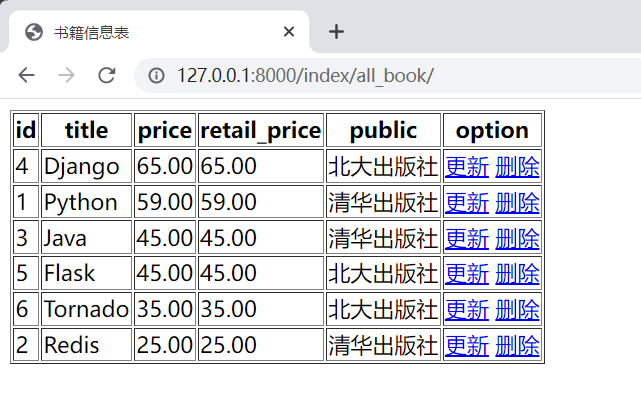
3、
接下来实现书籍信息的添加功能,编写 add_book.html 页面,代码如下所示:
<!DOCTYPE html>
<html lang="en">
<head>
<meta charset="UTF-8">
<title>添加书籍信息</title>
</head>
<body>
<form action="/index/add_book/" method="post">
{% csrf_token %}
<p>
title : <input type="text" name="title">
</p>
<p>
price : <input type="text" name="price">
</p>
<p>
retail_price : <input type="text" name="retail_price">
</p>
<p>
public : <input type="text" name="pub">
</p>
<p>
<!--按钮的值提交--> <input type="submit" value="提交">
</p>
</form>
</body>
</html>上述我们编写完成了添加书籍信息的页面,然后需要在视图层 index\views.py 中编写提交书籍信息的逻辑代码。如下所示:
def add_book(request):
if request.method == 'GET':
return render(request, 'index/add_book.html')
elif request.method == 'POST':
#添加书籍
title = request.POST.get('title')
if not title:
return HttpResponse('请给出一个正确的title')
pub = request.POST.get('pub')
price = float(request.POST.get('price','999.99'))
if not price:
return HttpResponse('请输入价格')
try:
retail_price = float(request.POST.get('retail_price'))
if not retail_price:
return HttpResponse('请输入市场价')
except Exception as e:
print(e)
#判断title是不是已经存在了
old_book = Book.objects.filter(title=title)
if old_book:
return HttpResponse('你输入的书籍系统已经存在 !')
try:
pub1=PubName.objects.get(pubname=str(pub))
Book.objects.create(title=title, price=price, retail_price=retail_price, pub=pub1)
except Exception as e:
print('Add ErrorReason is %s'%(e))
return HttpResponseRedirect('/index/all_book')
return HttpResponse('请使用正确Http请求方法 !')最后将路由映射关系配置完成,通过上面的代码我们就完成书籍信息的添加的功能,访问127.0.0.1/index/add_book,可得如下界面:
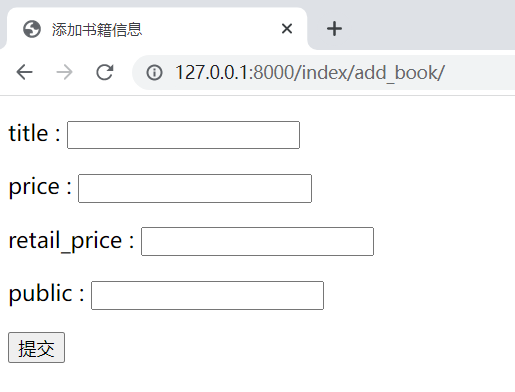
输入完上述信息点击添加按钮,会自动跳转到图书浏览目录页面:
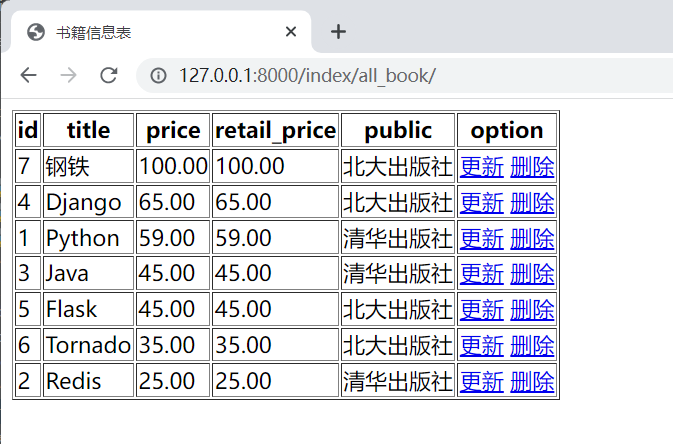
在本节中,我们实现了书籍的全量展示功能以及图书的添加功能。上述代码理解起来会比较的直观简单,但是实际编写起来,会有很多需要注意的细节,需要开发者做到思维缜密,当然这个能力并非一蹴而就,需要大家不断的练习与自我提升才可以。本节的任务是实现添加、更新和删除功能。
如下图:
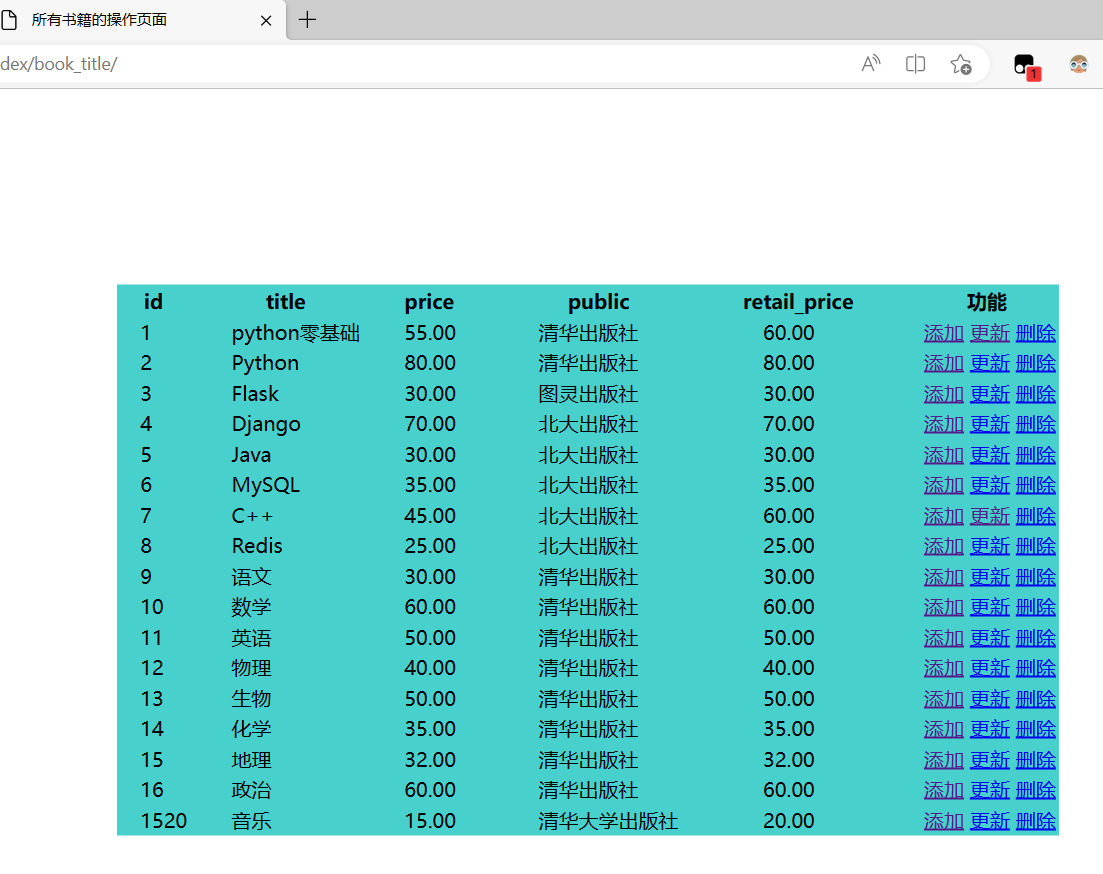
添加页面:

更新页面:
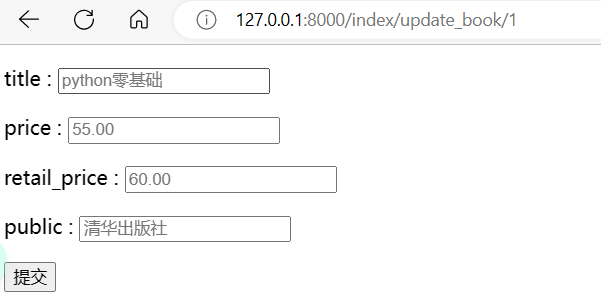
删除页面:

点击后,音乐书籍消失,重新返回所有书籍的页面

二、Django静态文件配置
那么关于django中静态文件的配置,我们就需要在settings配置文件里面做一些修改。
1、settings配置文件
STATIC_URL = '/static/'
STATICFILES_DIRS = [
os.path.join(BASE_DIR, 'commomStatic') # 第二个参数就是项目中存放静态文件的文件夹名称
]2、创建静态文件目录
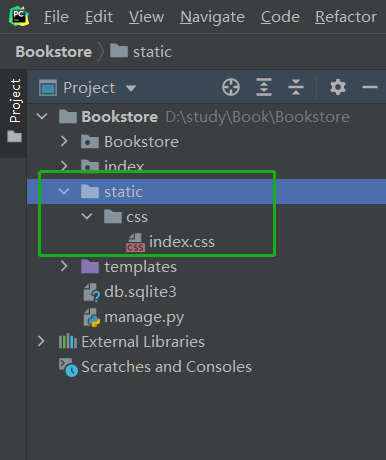
前端页面引入静态文件的写法如下:
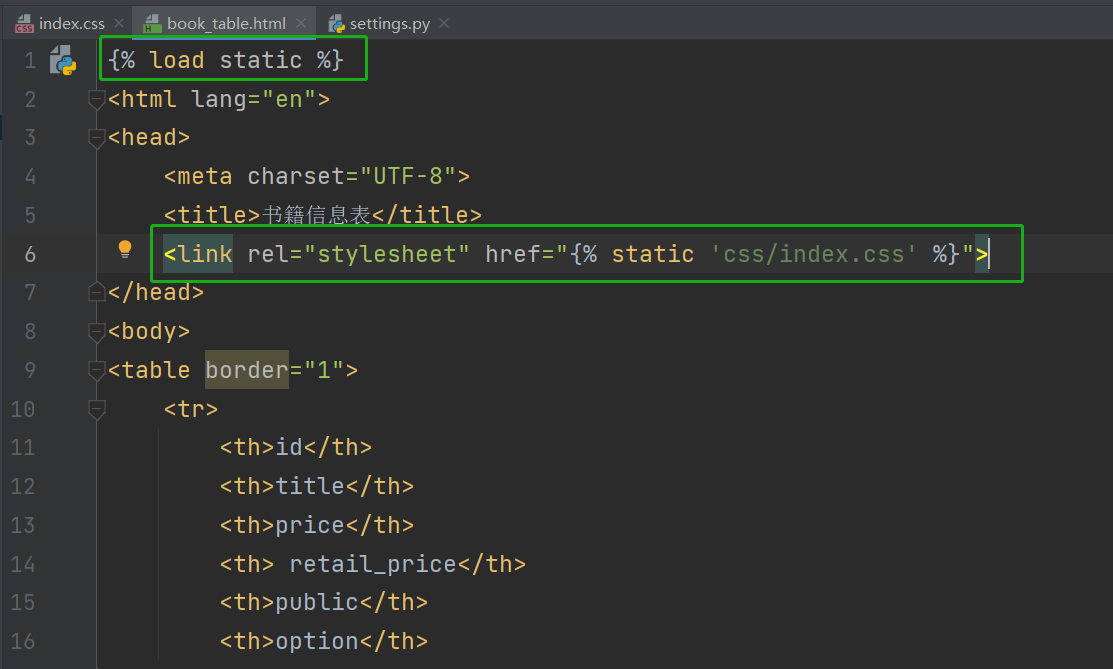
3、图片和js文件的嵌入
图片:
{% load static %}
<img src="{% static "images/hi.jpg" %}" alt="Hi!" />js文件:
{% load static %}
<script src="{% static "mytest.js" %}"></script>

